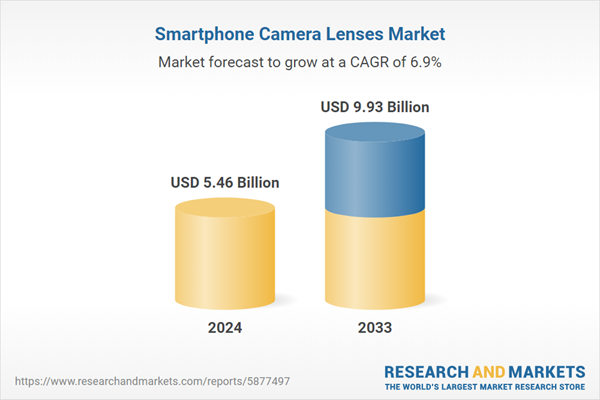A smartphone camera lens is a compact optical component that captures and focuses light onto the image sensor of smartphones for capturing images, recording videos and making video calls. It includes wide-angle, telephoto, macro, and fisheye lenses, which are made using special glass and plastic elements. It relies on various software features and technologies, such as image stabilization, autofocus, and low-light enhancement, which enhance the overall image and video quality to offer better user experience. It also allows individuals to instantly share their videos and photos on social media platforms and save them to the cloud storage. Besides this, they assist users in capturing high-quality videos, landscape photography, and architectural shots.
Smartphone Camera Lenses Market Trends:
The increasing sales of smartphones, rising demand for high-quality mobile photography, and the growing influence of social media platforms that rely on visual content are among the key factors driving the market. Additionally, consumers are purchasing smartphones with advanced camera capabilities and versatile lenses that help capture stunning images in various conditions. Leading smartphone companies are focusing on improving smartphone camera systems to offer better image quality, zoom capabilities, and creative options. They are also enhancing video recording features, including higher frame rates, improved stabilization, high dynamic range (HDR), and 8K video recording. Furthermore, the integration of image stabilization and computational photography technologies is attracting a wider consumer base. Smartphone manufacturers are also collaborating with established camera brands to enhance the camera capabilities of their devices. Besides this, the incorporation of machine learning (ML) and artificial intelligence (AI) technologies into camera systems is improving image processing, low-light performance, and portrait mode effects and producing images with better dynamic range, noise reduction, and overall quality. Additionally, night mode features, enabled by software enhancements, allow smartphones to capture well-exposed and detailed images in challenging lighting conditions. Apart from this, the rising trend of multi-camera setups in smartphones, featuring multiple lenses with different focal lengths, is strengthening the market growth. The integration of wide-angle, telephoto, and macro lenses in smartphones allows users to switch between different lenses for various shooting scenarios, provides greater versatility, and enhances the overall photography experience.Key Market Segmentation:
The publisher provides an analysis of the key trends in each segment of the global smartphone camera lenses market, along with forecasts at the global, regional, and country levels from 2025-2033. Our report has categorized the market based on technology type, compatibility, and distribution channel.Technology Type Insights:
- Wide Angle
- Fisheye
- Telephoto
- Others
Compatibility Insights:
- iPhone
- Android
- Multidevice
Distribution Channel Insights:
- Online
- Offline
Regional Insights:
- North America
- United States
- Canada
- Asia-Pacific
- China
- Japan
- India
- South Korea
- Australia
- Indonesia
- Others
- Europe
- Germany
- France
- United Kingdom
- Italy
- Spain
- Russia
- Others
- Latin America
- Brazil
- Mexico
- Others
- Middle East and Africa
Competitive Landscape:
The report has also provided a comprehensive analysis of the competitive landscape in the global smartphone camera lenses market. Detailed profiles of all major companies have been provided. Some of the companies covered include Apexelin Private Limited, Bitplay Store International, Cam Kix, Eastman Kodak Company, Kantatsu Co. Ltd. (Kanematsu Corporation), Olloclip LLC, Sekonix Co. Ltd., ShiftCam Global Official, Xenvo, etc. Kindly note that this only represents a partial list of companies, and the complete list has been provided in the report.Key Questions Answered in This Report:
- How has the global smartphone camera lenses market performed so far, and how will it perform in the coming years?
- What are the drivers, restraints, and opportunities in the global smartphone camera lenses market?
- What is the impact of each driver, restraint, and opportunity on the global smartphone camera lenses market?
- What are the key regional markets?
- \Which countries represent the most attractive smartphone camera lenses market?
- What is the breakup of the market based on the technology type?
- Which is the most attractive technology type in the smartphone camera lenses market?
- What is the breakup of the market based on compatibility?
- Which is the most attractive compatibility in the smartphone camera lenses market?
- What is the breakup of the market based on the distribution channel?
- What is the most attractive distribution channel in the smartphone camera lenses market?
- What is the competitive structure of the global smartphone camera lenses market?
- Who are the key players/companies in the global smartphone camera lenses market?
Table of Contents
Companies Mentioned
- Apexelin Private Limited
- Bitplay Store International
- Cam Kix
- Eastman Kodak Company
- Kantatsu Co. Ltd. (Kanematsu Corporation)
- Olloclip LLC
- Sekonix Co. Ltd.
- ShiftCam Global Official
- Xenvo
Table Information
| Report Attribute | Details |
|---|---|
| No. of Pages | 141 |
| Published | March 2025 |
| Forecast Period | 2024 - 2033 |
| Estimated Market Value ( USD | $ 5.46 Billion |
| Forecasted Market Value ( USD | $ 9.93 Billion |
| Compound Annual Growth Rate | 6.9% |
| Regions Covered | Global |
| No. of Companies Mentioned | 9 |









